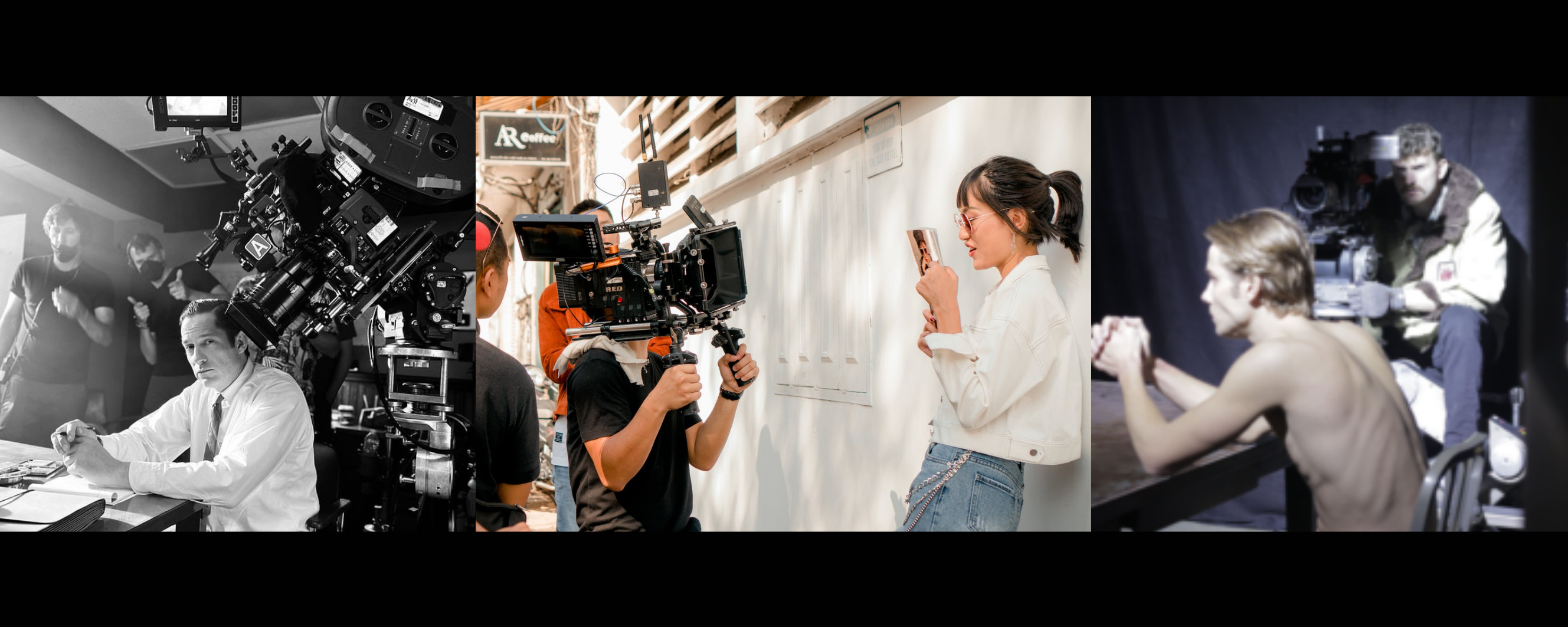LEARN TO ACT ON-SCREEN AT ONE OF THE BEST ACTING SCHOOLS
Is filmmaking and conveying stories through film your passion? Study in one of the best film and acting schools in California. We are considered one of the top film colleges in LA, Learn Filmmaking and how to create films in a class. The emphasis is on hands-on experience. Students gain invaluable experience directing and shooting their own films and serving as integral crew members on other students’ films. In their numerous projects, students take on roles such as director, cinematographer, writer and editor and experience first-hand what it’s like to be a part of a film production. Each student will write, shoot, direct and edit her/his own films.
“The best way to become a filmmaker is to simply start making films.”
LEARN FILMMAKING AT ONE OF THE BEST FILM SCHOOLS IN THE U.S.A.
Associate Degree of Occupational Science in Fine Arts and Filmmaking
Film Directing Program Classes

1st Semester
Improv
Students learn the fundamental guidelines of starting and sustaining a good, improvised 3-5 minute
scene. They will learn to bypass their mind and hooking into their impulses by saying yes to everything and will
trust where their imagination leads them.
Course Title: Acting Technique: Meisner
Through improvisation and scene work, Actors explore basic concepts where they learn the Meisner
approach to acting with a focus on creating and living in imaginary circumstances. Learn to work more
independently, improve rehearsal and research skills, and strengthen vocal and movement skills. Enrollment
limited.
American Film History
Students will learn all about the film history. How films came up, how different filming methods evolved and how hollywood came up.
Meisner Technique
Students learn all about Sanford Meisner and his acting technique where they learn exercises to get into the character and learn acting through repetition and listening..
This class will give you hands on experience with camera and lighting equipment and techniques. A complete understanding of issues related to exposure, f-stops, focal length, composition, digital cinema workflows, and color correction.
Structured in both a lecture and workshop format, Fundamentals of Directing will cover all the principles, procedures, and practices of directing for film. We will explore text analysis, the audition process, casting, design & collaboration, principles of composition, blocking & motivation, all in pursuit of the art of storytelling. Exercises, reading assignments, video viewings and lectures will help us through a series of manageable directing projects designed to help aspiring directors learn the basics of the craft of directing.
Discuss and analyze the theme of the movie – assessing different scenes to actors in class and have directors
direct them asking the following questions.
In this class, we will explore the world of the short narrative script. Through writing exercises and assignments, we will develop your skill in creating outlines, talking about short films and scripts, and utilizing symbols, metaphors, allegories and other storytelling devices to enrich your script.
To provide each student with a diverse array of tools to help actors find emotional triggers, with the ability to
deploy these triggers rapidly and repeatedly as the scenario dictates. To teach students how to speak to actors
about endowing objects and creating characters with emotional depth. Students in the class will gain a
comprehensive understanding of the major different schools of thought in contemporary acting, the
methodologies of Sanford Meisner, Lee Strasberg, Stella Adler, Michael Bobby Lewis, Chekhov, Konstantin
Stanislavski.

2nd Semester
This class is geared on how to work and talk to actors. This will facilitate a collaboration with director and actor to achieve a maximum creative journey.
Students will take what they’ve learned from writing a short film, create characters and outline, and start to work on a full-length feature screenplay from begin to end. They will be able to cast actors from the acting program for table readings and receive feedback in class.
The time has come!
You are on set and filming. This is where you will learn what feels easyand where your challenges are. The filmmaker will learn that they are the point person for everything. Everyone will ask a million questions, and they have to have a good answer for it. They have to think quickly on their feet, be tireless, and inspire their cast and crew in order to fulfill their vision.
Students will watch the dailies, select the best takes, and piece together what will be their first cut. They will get feedback, go back to the drawing board, and do another cut. They will learn how to pick and add music, do color correction and sound design, and create visual effects if the film requires any.
Producing a web series
In the class the students are going to write, produce and shoot a web series. They will learn the differences between a series and a movie in writing and how you stretch the story out.
Directing a web series
We will go through all the important things that students need to keep in mind when it comes to directing and filming a web series.

3rd Semester
Stanislavski Technique
The concentration in this class is on effective memory, learning how to use sensory, emotional recall and
memories to trigger yourself in your acting. Through Scenes and Monologues, Actors will learn how to use
themselves personally, deeply in a scene and trust the substitutions and personalizations that come up. The more
personal they make it, the more universal the story can be told.
This class is geared on getting hands on experience working with actors in a less pressurized environment. Aspiring filmmakers will pick a scene and cast it from a group of actors from the acting program. This exercise will be repeated twice.
Stage Combat Filming
In Fight Choreography, the students will practice safe fighting and Stage Combat Techniques on set and on
stage as well as study choreography.
This class is geared on how to work and talk to actors. This will facilitate a collaboration with director and actor to achieve a maximum creative journey.
Improv
Students will continue to work out their improvisational skills and will learn to sustain an improvised scene for
5 to 8 minutes. They will instantly enter a character that they can inhabit and play with.
Discuss and analyze the theme of the movie – assessing different scenes to actors in class and have directors
direct them asking the following questions.
Music Video
Students will learn to shoot a music video and will be able to apply their skills that they learned from their previous projects in class.

4th Semester
Strassberg Acting Technique
You will learn the core of our work, the first half of each class is devoted to a sequence of concentration
exercises to develop actors’ relaxation and effective memory: both sensory and emotional. The sense memory
exercises utilize imaginary objects that most people deal with every day, so that actors can begin to create a
simple reality for themselves. The second half of the class consists of scene and monologue work, during which
time students apply what they have learned in their exercises to their roles. Improvisation is used to help create
actual experience.
Production Design is an examination of the role of the production designer and art director in motion pictures, television or new media. Students will learn what art direction brings to the narrative storytelling process and how to identify this while watching a film or television show. They will work on projects that will give them hands on experience at the design process solving real world problems with skills they learn in class.
Production Design is an examination of the role of the production designer and art director in motion pictures, television or new media. Students will learn what art direction brings to the narrative storytelling process and how to identify this while watching a film or television show. They will work on projects that will give them hands on experience at the design process solving real world problems with skills they learn in class.
Make a Movie Part 1 – Pre-Production
Make a Movie Part 2 – Proof of Concept
Make a Movie Part 3 – Post Production
Students will watch the dailies, select the best takes, and piece together what will be their first cut. They will get feedback, go back to the drawing board, and do another cut. They will learn how to pick and add music, do color correction and sound design, and create visual effects if the film requires any.

Electives
Art of the pitch
Our students are going to learn how to pitch their project, which is probably one of the most important things one has to know when trying to get funding etc. for a project.
Casting
We will give tips about casting and what keys are to be successful in it and to get cast in the end.
Outline Treatment
The class will teach how to present the story of ones script, character descriptions etc. in just a few pages.
Production Design is an examination of the role of the production designer and art director in motion pictures, television or new media. Students will learn what art direction brings to the narrative storytelling process and how to identify this while watching a film or television show. They will work on projects that will give them hands on experience at the design process solving real world problems with skills they learn in class.
Accent Reduction
In this class, students will learn a typical american accent, which is very important for movie roles. We will show them different exercises to loosen the tongue and jaw which is helping a lot of students.

